Index FIAT DOBLO COMBI 2012 Owner handbook (in English)
[x] Cancel search | Manufacturer: FIAT, Model Year: 2012, Model line: DOBLO COMBI, Model: FIAT DOBLO COMBI 2012Pages: 283, PDF Size: 6.31 MB
Page 207 of 283
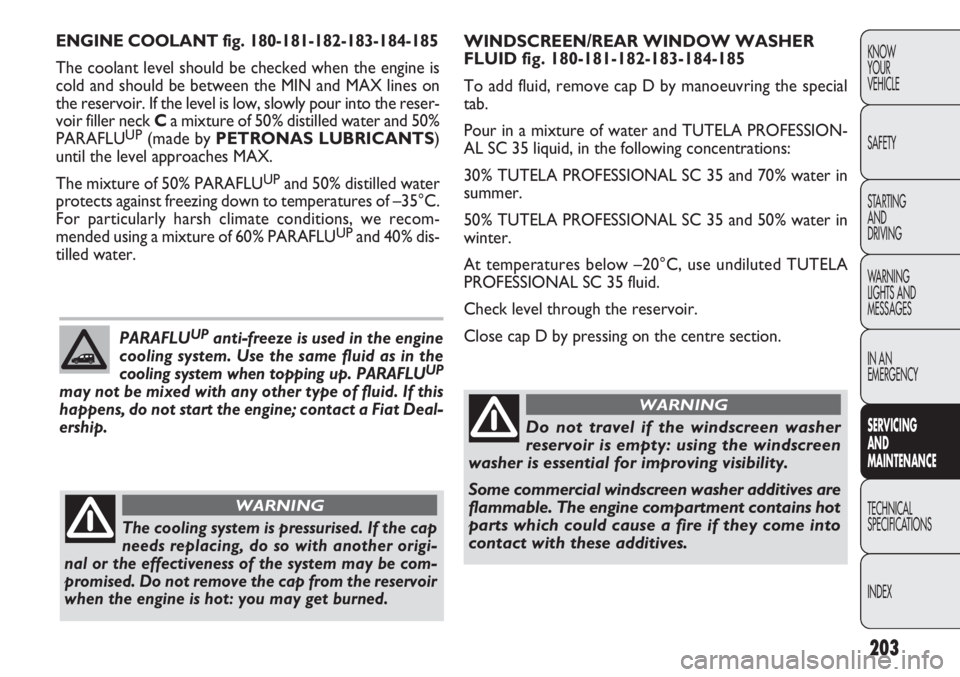
203
KNOW
YOUR
VEHICLE
SAFETY
STARTING
AND
DRIVING
WARNING
LIGHTS AND
MESSAGES
IN AN
EMERGENCY
SERVIC
ING
AND
MAINTENANCE
TECHNICAL
SPECIFICA TIONS
INDEX
WINDSCREEN/REAR WINDOW WASHER
FLUID fig. 180-181-182-183-184-185
To add fluid, remove cap D by manoeuvring the special
tab.
Pour in a mixture of water and TUTELA PROFESSION-
AL SC 35 liquid, in the following concentrations:
30% TUTELA PROFESSIONAL SC 35 and 70% water in
summer.
50% TUTELA PROFESSIONAL SC 35 and 50% water in
winter.
At temperatures below –20°C, use undiluted TUTELA
PROFESSIONAL SC 35 fluid.
Check level through the reservoir.
Close cap D by pressing on the centre section.
ENGINE COOLANT fig. 180-181-182-183-184-185
The coolant level should be checked when the engine is
cold and should be between the MIN and MAX lines on
the reservoir. If the level is low, slowly pour into the reser-
voir filler neck C
a mixture of 50% distilled water and 50%
PARAFLU
UP(made by PETRONAS LUBRICANTS )
until the level approaches MAX.
The mixture of 50% PARAFLU
UPand 50% distilled water
protects against freezing down to temperatures of –35°C.
For particularly harsh climate conditions, we recom-
mended using a mixture of 60% PARAFLU
UPand 40% dis-
tilled water.
PARAFLU
UPanti-freeze is used in the engine
cooling system. Use the same fluid as in the
cooling system when topping up. PARAFLU
UP
may not be mixed with any other type of fluid. If this
happens, do not start the engine; contact a Fiat Deal-
ership.
The cooling system is pressurised. If the cap
needs replacing, do so with another origi-
nal or the effectiveness of the system may be com-
promised. Do not remove the cap from the reservoir
when the engine is hot: you may get burned.
WARNING
Do not travel if the windscreen washer
reservoir is empty: using the windscreen
washer is essential for improving visibility.
Some commercial windscreen washer additives are
flammable. The engine compartment contains hot
parts which could cause a fire if they come into
contact with these additives.
WARNING
Page 208 of 283
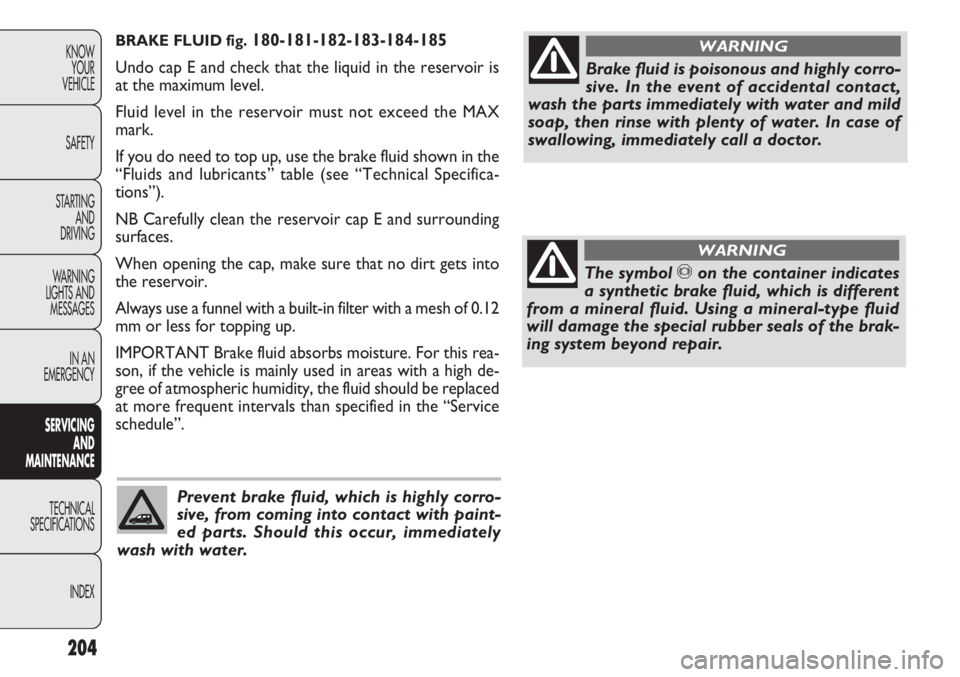
BRAKE FLUID fig. 180-181-182-183-184-185
Undo cap E and check that the liquid in the reservoir is
at the maximum level.
Fluid level in the reservoir must not exceed the MAX
mark.
If you do need to top up, use the brake fluid shown in the
“Fluids and lubricants” table (see “Technical Specifica-
tions”).
NB Carefully clean the reservoir cap E and surrounding
surfaces.
When opening the cap, make sure that no dirt gets into
the reservoir.
Always use a funnel with a built-in filter with a mesh of 0.12
mm or less for topping up.
IMPORTANT Brake fluid absorbs moisture. For this rea-
son, if the vehicle is mainly used in areas with a high de-
gree of atmospheric humidity, the fluid should be replaced
at more frequent intervals than specified in the “Service
schedule”.
204
KNOW YOUR
VEHICLE
SAFETY
STARTING AND
DRIVING
WARNING
LIGHTS AND MESSAGES
IN AN
EMERGENCY
SERV IC
ING
AND
MAINTENANCE
TECHNICAL
SPECIFICA TIONS
INDEX
Prevent brake fluid, which is highly corro-
sive, from coming into contact with paint-
ed parts. Should this occur, immediately
wash with water.
Brake fluid is poisonous and highly corro-
sive. In the event of accidental contact,
wash the parts immediately with water and mild
soap, then rinse with plenty of water. In case of
swallowing, immediately call a doctor.
WARNING
The symbol π on the container indicates
a synthetic brake fluid, which is different
from a mineral fluid. Using a mineral-type fluid
will damage the special rubber seals of the brak-
ing system beyond repair.
WARNING
Page 209 of 283
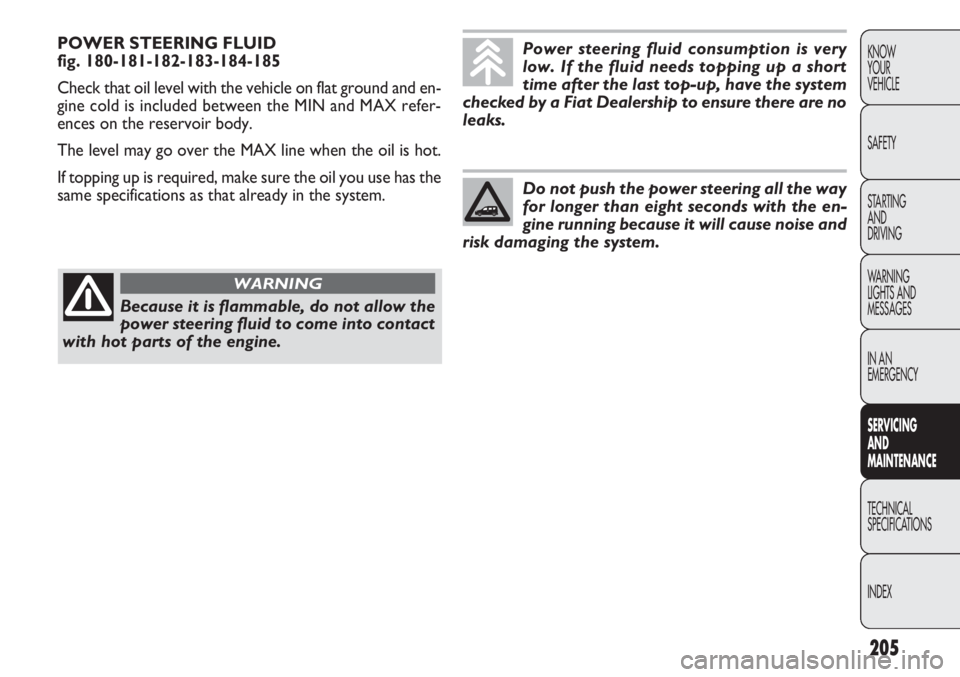
205
KNOW
YOUR
VEHICLE
SAFETY
STARTING
AND
DRIVING
WARNING
LIGHTS AND
MESSAGES
IN AN
EMERGENCY
SERVIC
ING
AND
MAINTENANCE
TECHNICAL
SPECIFICA TIONS
INDEX
POWER STEERING FLUID
fig. 180-181-182-183-184-185
Check that oil level with the vehicle on flat ground and en-
gine cold is included between the MIN and MAX refer-
ences on the reservoir body.
The level may go over the MAX line when the oil is hot.
If topping up is required, make sure the oil you use has the
same specifications as that already in the system.Power steering fluid consumption is very
low. If the fluid needs topping up a short
time after the last top-up, have the system
checked by a Fiat Dealership to ensure there are no
leaks.
Do not push the power steering all the way
for longer than eight seconds with the en-
gine running because it will cause noise and
risk damaging the system.
Because it is flammable, do not allow the
power steering fluid to come into contact
with hot parts of the engine.
WARNING
Page 210 of 283
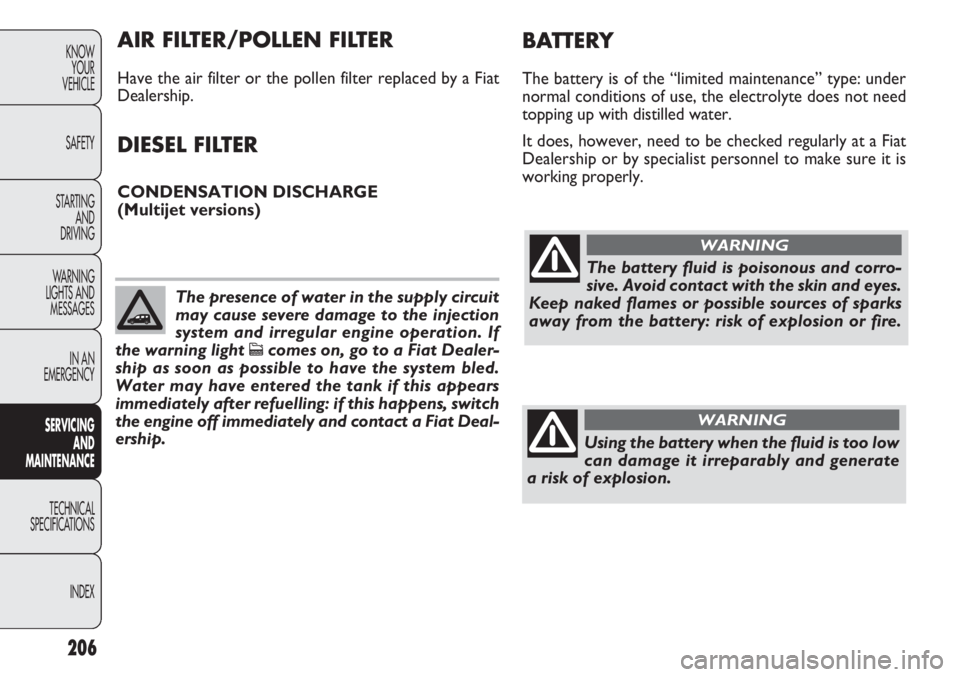
206
KNOWYOUR
VEHICLE
SAFETY
STARTING AND
DRIVING
WARNING
LIGHTS AND MESSAGES
IN AN
EMERGENCY
SERV IC
ING
AND
MAINTENANCE
TECHNICAL
SPECIFICA TIONS
INDEX
The battery fluid is poisonous and corro-
sive. Avoid contact with the skin and eyes.
Keep naked flames or possible sources of sparks
away from the battery: risk of explosion or fire.
WARNING
Using the battery when the fluid is too low
can damage it irreparably and generate
a risk of explosion.
WARNING
AIR FILTER/POLLEN FILTER
Have the air filter or the pollen filter replaced by a Fiat
Dealership.
DIESEL FILTER
CONDENSATION DISCHARGE
(Multijet versions)
BAT T ERY
The battery is of the “limited maintenance” type: under
normal conditions of use, the electrolyte does not need
topping up with distilled water.
It does, however, need to be checked regularly at a Fiat
Dealership or by specialist personnel to make sure it is
working properly.
The presence of water in the supply circuit
may cause severe damage to the injection
system and irregular engine operation. If
the warning light
ccomes on, go to a Fiat Dealer-
ship as soon as possible to have the system bled.
Water may have entered the tank if this appears
immediately after refuelling: if this happens, switch
the engine off immediately and contact a Fiat Deal-
ership.
Page 211 of 283
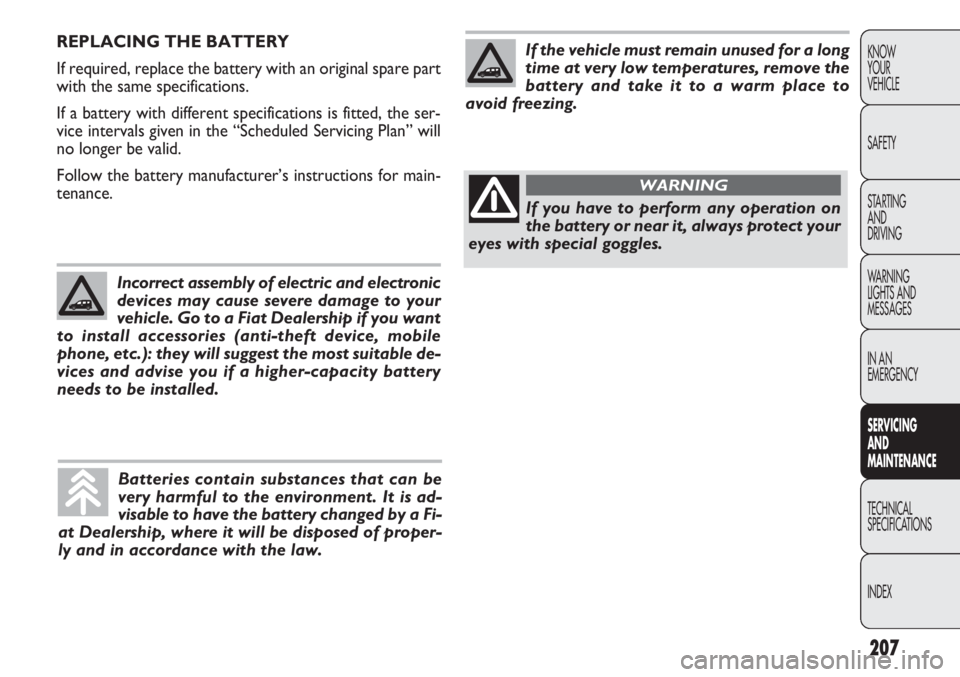
207
KNOW
YOUR
VEHICLE
SAFETY
STARTING
AND
DRIVING
WARNING
LIGHTS AND
MESSAGES
IN AN
EMERGENCY
SERVIC
ING
AND
MAINTENANCE
TECHNICAL
SPECIFICA TIONS
INDEX
REPLACING THE BATTERY
If required, replace the battery with an original spare part
with the same specifications.
If a battery with different specifications is fitted, the ser-
vice intervals given in the “Scheduled Servicing Plan” will
no longer be valid.
Follow the battery manufacturer’s instructions for main-
tenance.
Incorrect assembly of electric and electronic
devices may cause severe damage to your
vehicle. Go to a Fiat Dealership if you want
to install accessories (anti-theft device, mobile
phone, etc.): they will suggest the most suitable de-
vices and advise you if a higher-capacity battery
needs to be installed.
Batteries contain substances that can be
very harmful to the environment. It is ad-
visable to have the battery changed by a Fi-
at Dealership, where it will be disposed of proper-
ly and in accordance with the law.
If the vehicle must remain unused for a long
time at very low temperatures, remove the
battery and take it to a warm place to
avoid freezing.
If you have to perform any operation on
the battery or near it, always protect your
eyes with special goggles.
WARNING
Page 212 of 283
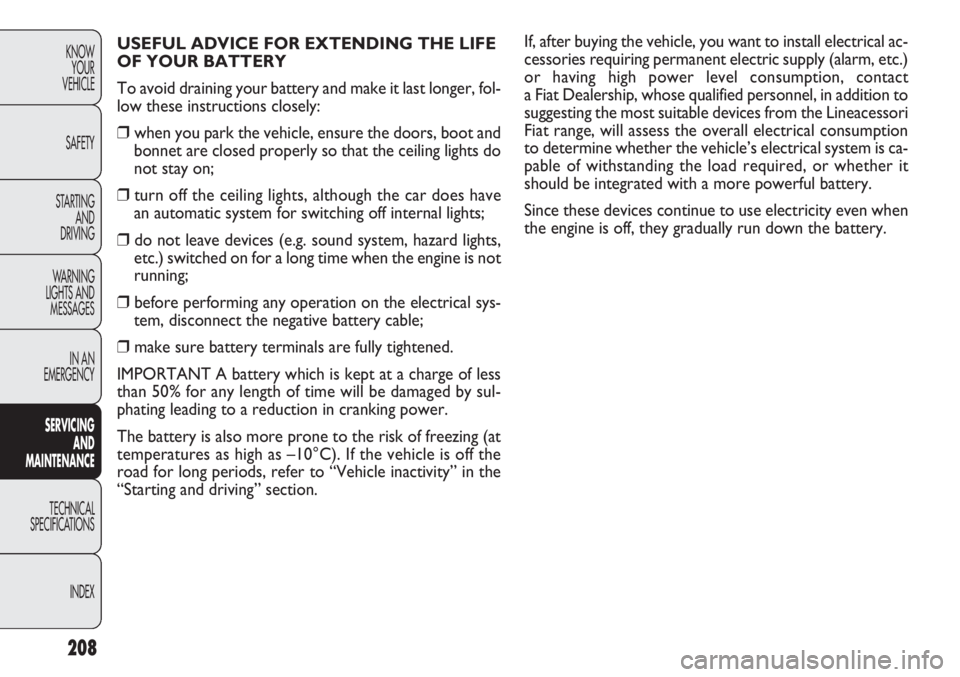
If, after buying the vehicle, you want to install electrical ac-
cessories requiring permanent electric supply (alarm, etc.)
or having high power level consumption, contact
a Fiat Dealership, whose qualified personnel, in addition to
suggesting the most suitable devices from the Lineacessori
Fiat range, will assess the overall electrical consumption
to determine whether the vehicle’s electrical system is ca-
pable of withstanding the load required, or whether it
should be integrated with a more powerful battery.
Since these devices continue to use electricity even when
the engine is off, they gradually run down the battery.
208
KNOWYOUR
VEHICLE
SAFETY
STARTING AND
DRIVING
WARNING
LIGHTS AND MESSAGES
IN AN
EMERGENCY
SERV IC
ING
AND
MAINTENANCE
TECHNICAL
SPECIFICA TIONS
INDEX
USEFUL ADVICE FOR EXTENDING THE LIFE
OF YOUR BATTERY
To avoid draining your battery and make it last longer, fol-
low these instructions closely:
❒ when you park the vehicle, ensure the doors, boot and
bonnet are closed properly so that the ceiling lights do
not stay on;
❒ turn off the ceiling lights, although the car does have
an automatic system for switching off internal lights;
❒ do not leave devices (e.g. sound system, hazard lights,
etc.) switched on for a long time when the engine is not
running;
❒ before performing any operation on the electrical sys-
tem, disconnect the negative battery cable;
❒ make sure battery terminals are fully tightened.
IMPORTANT A battery which is kept at a charge of less
than 50% for any length of time will be damaged by sul-
phating leading to a reduction in cranking power.
The battery is also more prone to the risk of freezing (at
temperatures as high as –10°C). If the vehicle is off the
road for long periods, refer to “Vehicle inactivity” in the
“Starting and driving” section.
Page 213 of 283
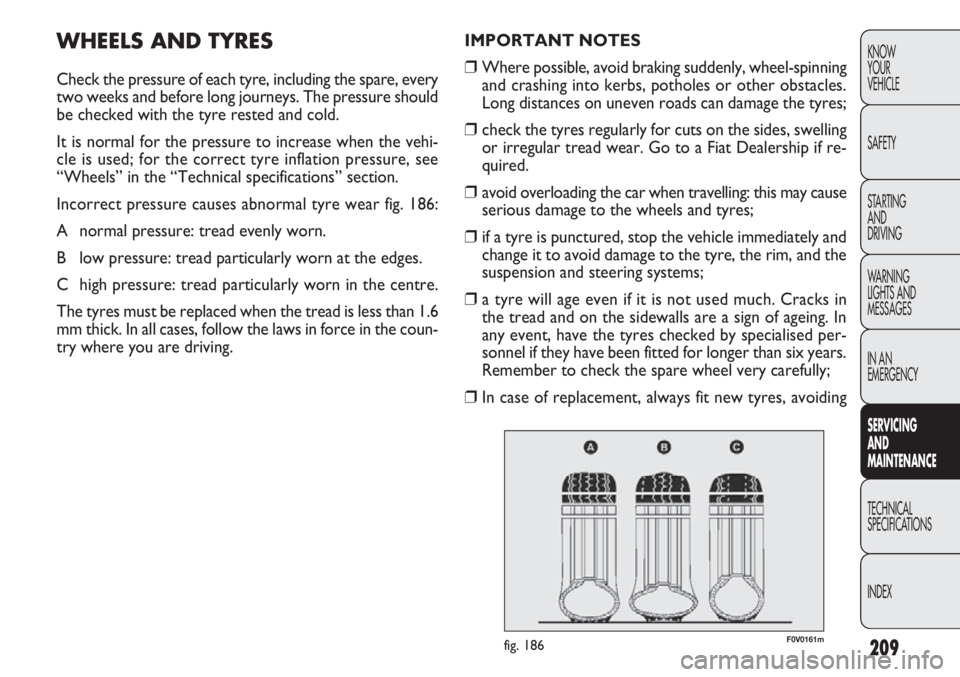
209
KNOW
YOUR
VEHICLE
SAFETY
STARTING
AND
DRIVING
WARNING
LIGHTS AND
MESSAGES
IN AN
EMERGENCY
SERVIC
ING
AND
MAINTENANCE
TECHNICAL
SPECIFICA TIONS
INDEX
IMPORTANT NOTES
❒ Where possible, avoid braking suddenly, wheel-spinning
and crashing into kerbs, potholes or other obstacles.
Long distances on uneven roads can damage the tyres;
❒ check the tyres regularly for cuts on the sides, swelling
or irregular tread wear. Go to a Fiat Dealership if re-
quired.
❒ avoid overloading the car when travelling: this may cause
serious damage to the wheels and tyres;
❒ if a tyre is punctured, stop the vehicle immediately and
change it to avoid damage to the tyre, the rim, and the
suspension and steering systems;
❒ a tyre will age even if it is not used much. Cracks in
the tread and on the sidewalls are a sign of ageing. In
any event, have the tyres checked by specialised per-
sonnel if they have been fitted for longer than six years.
Remember to check the spare wheel very carefully;
❒ In case of replacement, always fit new tyres, avoidingWHEELS AND TYRES
Check the pressure of each tyre, including the spare, every
two weeks and before long journeys. The pressure should
be checked with the tyre rested and cold.
It is normal for the pressure to increase when the vehi-
cle is used; for the correct tyre inflation pressure, see
“Wheels” in the “Technical specifications” section.
Incorrect pressure causes abnormal tyre wear fig. 186:
A normal pressure: tread evenly worn.
B low pressure: tread particularly worn at the edges.
C high pressure: tread particularly worn in the centre.
The tyres must be replaced when the tread is less than 1.6
mm thick. In all cases, follow the laws in force in the coun-
try where you are driving.
F0V0161mfig. 186
Page 214 of 283
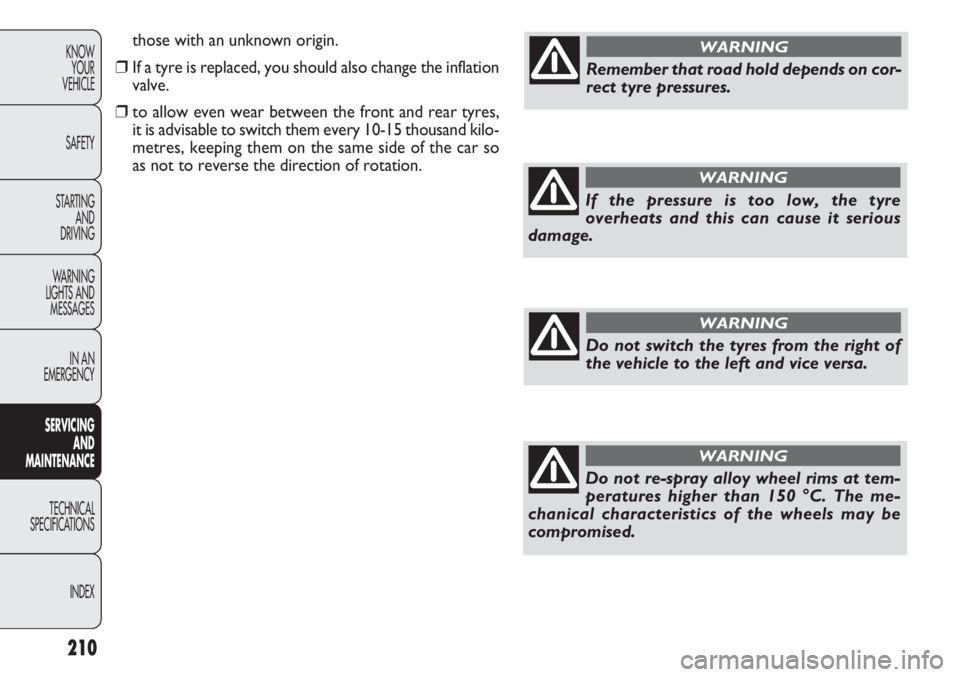
210
KNOWYOUR
VEHICLE
SAFETY
STARTING AND
DRIVING
WARNING
LIGHTS AND MESSAGES
IN AN
EMERGENCY
SERV IC
ING
AND
MAINTENANCE
TECHNICAL
SPECIFICA TIONS
INDEX
those with an unknown origin.
❒ If a tyre is replaced, you should also change the inflation
valve.
❒ to allow even wear between the front and rear tyres,
it is advisable to switch them every 10-15 thousand kilo-
metres, keeping them on the same side of the car so
as not to reverse the direction of rotation.
Remember that road hold depends on cor-
rect tyre pressures.
WARNING
If the pressure is too low, the tyre
overheats and this can cause it serious
damage.
WARNING
Do not switch the tyres from the right of
the vehicle to the left and vice versa.
WARNING
Do not re-spray alloy wheel rims at tem-
peratures higher than 150 °C. The me-
chanical characteristics of the wheels may be
compromised.
WARNING
Page 215 of 283
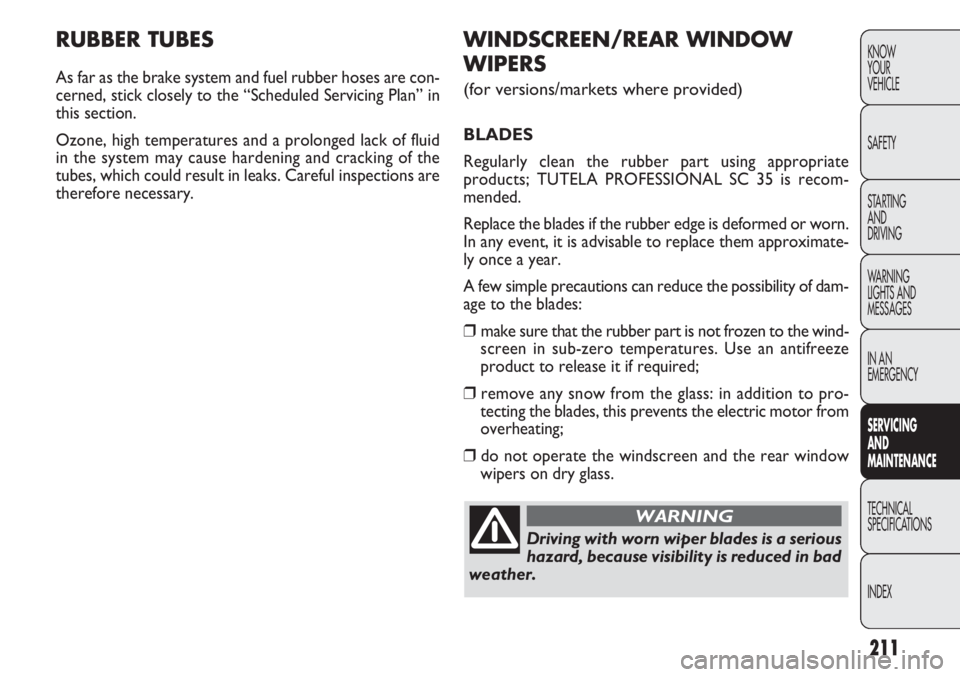
211
KNOW
YOUR
VEHICLE
SAFETY
STARTING
AND
DRIVING
WARNING
LIGHTS AND
MESSAGES
IN AN
EMERGENCY
SERVIC
ING
AND
MAINTENANCE
TECHNICAL
SPECIFICA TIONS
INDEX
RUBBER TUBES
As far as the brake system and fuel rubber hoses are con-
cerned, stick closely to the “Scheduled Servicing Plan” in
this section.
Ozone, high temperatures and a prolonged lack of fluid
in the system may cause hardening and cracking of the
tubes, which could result in leaks. Careful inspections are
therefore necessary.
WINDSCREEN/REAR WINDOW
WIPERS
(for versions/markets where provided)
BLADES
Regularly clean the rubber part using appropriate
products; TUTELA PROFESSIONAL SC 35 is recom-
mended.
Replace the blades if the rubber edge is deformed or worn.
In any event, it is advisable to replace them approximate-
ly once a year.
A few simple precautions can reduce the possibility of dam-
age to the blades:
❒ make sure that the rubber part is not frozen to the wind-
screen in sub-zero temperatures. Use an antifreeze
product to release it if required;
❒ remove any snow from the glass: in addition to pro-
tecting the blades, this prevents the electric motor from
overheating;
❒ do not operate the windscreen and the rear window
wipers on dry glass.
Driving with worn wiper blades is a serious
hazard, because visibility is reduced in bad
weather.
WARNING
Page 216 of 283
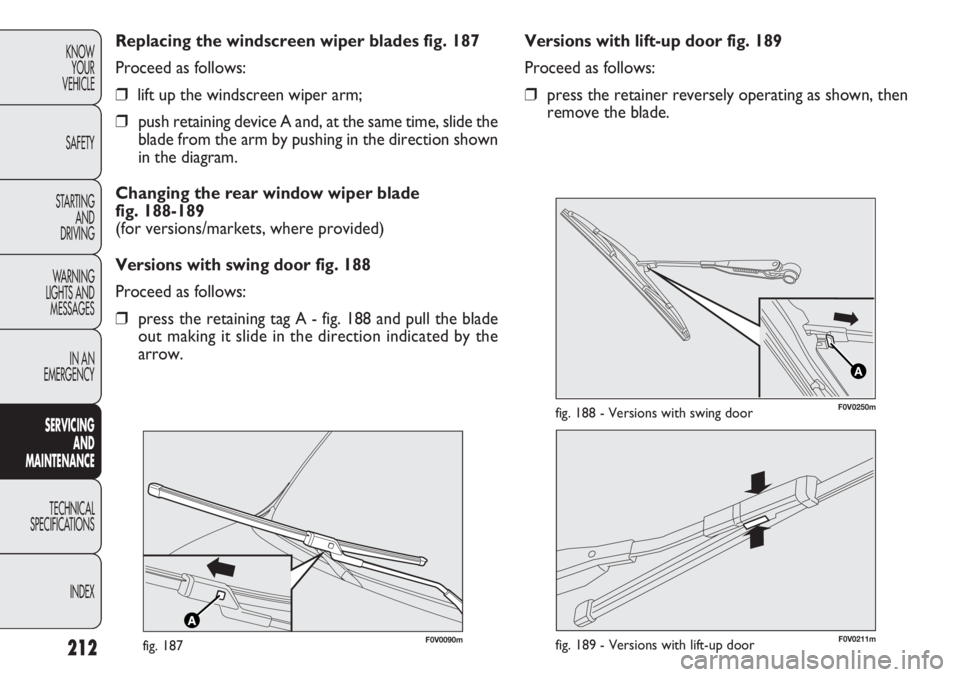
212
KNOWYOUR
VEHICLE
SAFETY
STARTING AND
DRIVING
WARNING
LIGHTS AND MESSAGES
IN AN
EMERGENCY
SERV IC
ING
AND
MAINTENANCE
TECHNICAL
SPECIFICA TIONS
INDEX
Versions with lift-up door fig. 189
Proceed as follows:
❒ press the retainer reversely operating as shown, then
remove the blade.
Replacing the windscreen wiper blades fig. 187
Proceed as follows:
❒
lift up the windscreen wiper arm;
❒ push retaining device A and, at the same time, slide the
blade from the arm by pushing in the direction shown
in the diagram.
Changing the rear window wiper blade
fig. 188-189
(for versions/markets, where provided)
Versions with swing door fig. 188
Proceed as follows:
❒ press the retaining tag A - fig. 188 and pull the blade
out making it slide in the direction indicated by the
arrow.
F0V0090mfig. 187F0V0211mfig. 189 - Versions with lift-up door
A
F0V0250mfig. 188 - Versions with swing door